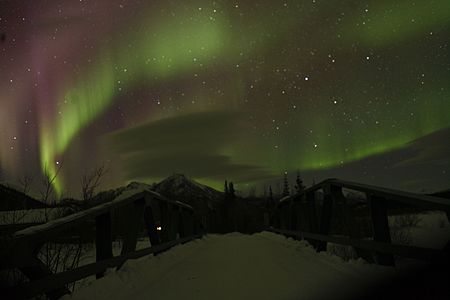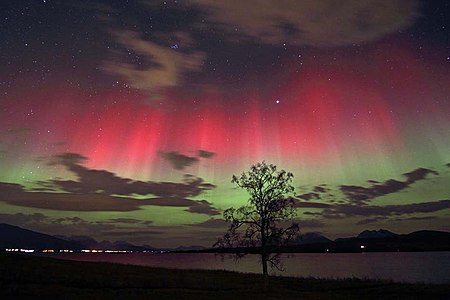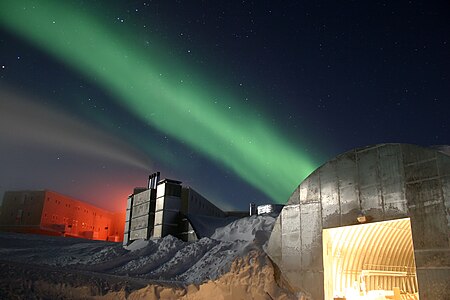極光
極光(粵拼:gik6 gwong1;英文:aurora / polar lights)係一種自然現象,指喺地球高緯度地區(極地)嘅天嗰度有陣時會見到嘅一種五顏六色嘅光,可以有好多種結構,包括帶形、弧形、幕形同放射形等。極光喺地球南極同北極都可以見到[1],南極嘅極光係南極光(southern lights,拉丁文係 aurora australis [2]),而北極嘅極光就係北極光(nothern lights,拉丁文係 aurora borealis [3])。
極光源於太陽風(solar wind)對地球大氣層磁層(magnetosphere)嘅干擾:太陽時不時會射出一啲帶電粒子(帶電荷嘅粒子)去佢周圍嘅太空嗰度;呢啲粒子有一部份會飛向地球,地球個磁場會令射埋佢嗰度嘅帶電粒子傾向飛去兩極;同時,好多氣體嘅粒子喺受到電磁干擾而離子化或者活躍化嗰陣,會發出唔同色水同款嘅光[4][5];因為噉,每當太陽活躍,造成勁嘅太陽風嗰時,好多時會搞到地球兩極上空嘅大氣層嘅粒子受到強烈嘅電磁干擾,會形成極光,極光嘅色同款就視乎是次太陽風活動涉及邊啲種類嘅粒子[1][3]。
自古以嚟,極光就一路引起人類嘅種種遐想。好似係北歐神話入面有傳說,話極光係女武神(valkyrie)嘅盾同護甲所反射嘅光:古代嘅維京人相信,女武神係一班女神,職責係幫眾神之父奧丁(Odin)將打仗戰死嘅勇士帶去英靈殿;俾女武神睇中係一種極高嘅榮譽-北歐神話相傳,俾女武神睇中嘅勇士會喺英靈殿嗰度受女武神嘅款待,而喺諸神黃昏(挪威文:Ragnarök)嗰陣,一眾英靈殿嘅勇士就會同奧丁以及眾神一齊上陣作戰[6]。到咗廿一世紀,地球科學等嘅科學領域經已對極光嘅真正來源有咗詳細嘅了解,但極光嘅姿態依然引起世人嘅讚嘆,有好多人會為咗睇極光而專登去北歐等地旅行[7]。
概論
[編輯]
極光帶
[編輯]極光通常會出現喺所謂嘅極光帶(auroral zone)入面:地球有個磁場,呢個磁場嘅兩個極咁啱分別喺接近北極同接近南極嘅位置,一股磁場會向帶電荷嘅物體施力,令呢啲物體傾向飛向磁極嘅方向,而一件帶電物體受嘅力傾向令佢飛去邊個磁極就視乎件物體嘅電荷係正定負(可以睇吓電磁學相關嘅嘢)。因為噉,地球有兩個極光帶(引起極光嘅帶電粒子傾向飛去嘅地區)-一個位於南極嗰頭,另一個位於北極嗰頭;極光帶一般有 3 至 6 緯度闊(好接近極地),大約離地磁極 10 至 20 度咁遠(地磁極唔係喺正地球極點嗰度而且會郁,呢點無論喺邊個時區都係一樣)[8];目前有極光出現緊嘅地區就係所謂嘅極光圈(auroral oval),極光圈會出現喺地球夜晚嗰面,位置會視乎太陽風活動等嘅因素定時定候有些少變化[9],而互聯網上有網站會定期報導目前極光圈喺乜位[10][11]。
南北極光
[編輯]極光可以分做北極光同南極光兩大種:
- 北極光會出現喺加拿大北部、格陵蘭、北歐、俄羅斯同阿拉斯加北部等地,拉丁文名係 aurora borealis ,呢個名係由伽俐略喺 1619 年改嘅-當中「aurora」源自羅馬神話裏面嘅晨曦女神奧羅拉個名,而「borealis」就係拉丁文入面「北方」噉解[12][13];
- 南極光喺特徵上同北極光大致相似,而且會同北極光同步起變化,會出現喺南極洲、智利、阿根廷南部、紐西蘭南部、同澳洲南部等地,而個拉丁文名係 aurora australis-當中「australis」正正就係拉丁文入面「南方」噉解[14]。
形成原因
[編輯]極光由太陽風同地球磁場相互產生作用嘅產物。由於太陽風係太陽猛咁噴等離子體,喺太陽風吹到某個星球附近時,受到磁場作用影響而進入兩極地區,咁啱撞到高層大氣而發光嘅現象。極光之所以靚兼變幻無窮,係因為某個星球嘅高空氣體有好多元素組成,所以撞到唔同元素氣體時,發嘅光色都唔同。
極光幻彩
[編輯]-
2005 年一夜阿拉斯加一個空軍基地上空嘅極光
-
2018 年阿拉斯加北部一夜
-
2016 年瑞典北部一夜
-
2013 年阿拉斯加一角
-
2017 年加拿大北部一夜
-
2017 年加拿大北部一處抬頭見到嘅景象
-
2011 年挪威北部一夜嘅紅綠色極光
-
2004 年加拿大由一架飛機影到嘅極光
-
2013 年南極一角極光下嘅冰屋
-
2010 年南極一角嘅銀白色極光
-
2015 年塔斯曼尼亞東南部一夜
-
2012 年 3 月一夜喺挪威一角影到嘅極光全景
睇埋
[編輯]參考書
[編輯]- 中国少年儿童百科全书 自然·环境 第256~257页 浙江教育出版社 ISBN 7-5338-1946-2/G·1942.
攷
[編輯]- ↑ 1.0 1.1 Auroras: What are they and how do you spot one in Australia?. Science.
- ↑ Shackleton, E. H. (1988). Aurora Australis. Library of Alexandria.
- ↑ 3.0 3.1 McLennan, J. C., & Shrum, G. M. (1925). On the origin of the auroral green line 5577 Å, and other spectra associated with aurora borealis. Proceedings of the Royal Society of London. Series A, Containing Papers of a Mathematical and Physical Character, 108(747), 501-512.
- ↑ Dopita, M. A., Isobe, S., & Meaburn, J. (1975). Large-scale ionization fronts and the nature and distribution of light scattering particles in the orion nebula. Astrophysics and Space Science, 34(1), 91-121.
- ↑ Frahm, R. A., Winningham, J. D., Sharber, J. R., Link, R., Crowley, G., Gaines, E. E., ... & Potemra, T. A. (1997). The diffuse aurora: A significant source of ionization in the middle atmosphere. Journal of Geophysical Research: Atmospheres, 102(D23), 28203-28214.
- ↑ Northern Lights Legends from Around the World.
- ↑ Genc, R. (2010). Turning weaknesses into strengths: Nordic tourism, potentials for growth and major challenges. Acta Universitatis Danubius. Œconomica, 6(1), 54-67.
- ↑ Feldstein, Y. I. (2011). "A Quarter Century with the Auroral Oval". EOS. 67 (40): 761.
- ↑ See: Loomis, Elias (November 1859). "The great auroral exhibition of August 28 to September, 1859". The American Journal of Science. 2nd series. 28: 385–408. Loomis, Elias (January 1860). "The great auroral exhibition of August 28 to September 4, 1859—2nd article". The American Journal of Science. 2nd series. 29: 92–97. Loomis, Elias (February 1860). "The great auroral exhibition of August 28 to September 4, 1859—3rd article". The American Journal of Science. 2nd series. 29: 249–266. Loomis, Elias (May 1860). "The great auroral exhibition of August 28 to September 4, 1859—4th article". The American Journal of Science. 2nd series. 29: 386–399. Loomis, Elias (July 1860). "The great auroral exhibition of August 28 to September 4, 1859, and the geographical distribution of auroras and thunder storms—5th article". The American Journal of Science. 2nd series. 30: 79–100. Loomis, Elias (November 1860). "The great auroral exhibition of August 28 to September 4, 1859—6th article". The American Journal of Science. 2nd series. 30: 339–361. Loomis, Elias (July 1861). "The great auroral exhibition of August 28 to September 4, 1859—7th article". The American Journal of Science. 2nd series. 32: 71–84. Loomis, Elias (September 1861). "On the great auroral exhibition of August 28 to September 4, 1859, and auroras generally—8th article". The American Journal of Science. 2nd series. 32: 318–335. Loomis, Elias (July 1862). "On electrical currents circulating near the earth's surface and their connection with the phenomena of the aurora polaris—9th article". The American Journal of Science. 2nd series. 34: 34–45.
- ↑ Tromholt, Sophus (1881). "Om Nordlysets Perioder / Sur les périodes de l'aurore boréale [On the periods of the aurora borealis]". Meteorologisk Aarbog for 1880. Part 1 (in Danish and French). Copenhagen, Denmark: Danske Meteorologiske Institut. pp. I–LX.
- ↑ Bruzek, A.; Durrant, C. J. (2012). Illustrated Glossary for Solar and Solar-Terrestrial Physics. Springer Science & Business Media. p. 190.
- ↑ Siscoe, G. L. (1986). "An historical footnote on the origin of 'aurora borealis'". History of Geophysics: Volume 2. History of Geophysics: Volume 2. Series: History of Geophysics. History of Geophysics. 2. pp. 11–14.
- ↑ Guiducci, Mario; Galilei, Galileo (1619). Discorso delle Comete [Discourse on Comets] (in Italian). Firenze (Florence), Italy: Pietro Cecconcelli. p. 39. On p. 39, Galileo explains that auroras are due to sunlight reflecting from thin, high clouds. From p. 39: " … molti di voi avranno più d'una volta veduto 'l Cielo nell' ore notturne, nelle parti verso Settentrione, illuminato in modo, che di lucidità non-cede alla piu candida Aurora, ne lontana allo spuntar del Sole; effetto, che per mio credere, non-ha origine altrode, che dall' essersi parte dell' aria vaporosa, che circonda la terra, per qualche cagione in modo più del consueto assottigliata, che sublimandosi assai più del suo consueto, abbia sormontato il cono dell' ombra terrestre, si che essendo la sua parte superiore ferita dal Sole abbia potuto rifletterci il suo splendore, e formarci questa boreale aurora." ( … many of you will have seen, more than once, the sky in the night hours, in parts towards the north, illuminated in a way that the clear [sky] does not yield to the brighter aurora, far from the rising of the sun; an effect that, by my thinking, has no other origin than being part of the vaporous air that surrounds the Earth, for some reason thinner than usual, which, being sublimated far more than usual, has risen above the cone of the Earth's shadow, so that its upper part, being struck by the sun['s light], has been able to reflect its splendor and to form this aurora borealis.)
- ↑ Østgaard, N.; Mende, S. B.; Frey, H. U.; Sigwarth, J. B.; Åsnes, A.; Weygand, J. M. (2007). "Auroral conjugacy studies based on global imaging". Journal of Atmospheric and Solar-Terrestrial Physics. 69 (3): 249.
拎
[編輯]- Aurora – FAQ.
- Aurora – Forecasting.
- Official MET aurora forecasting in Iceland.
- Aurora Borealis –Predicting.
- Solar Terrestrial Data – Online Converter – Northern Lights Latitude.
- NASA –Carrington Super Flare.
- Aurora Live Europe – Aurora forecasts for middle latitudes in Europe.
- 多媒體:
- Amazing time-lapse video of Aurora Borealis – Shot in Iceland over the winter of 2013/2014.
- Popular video of Aurora Borealis – Taken in Norway in 2011.
- Aurora Photo Gallery – Views taken 2009–2011.
- Aurora Photo Gallery – "Full-Sky Aurora" over Eastern Norway. December 2011.
- Videos and Photos – Auroras at Night.
- Video (04:49) – Aurora Borealis –How The Northern Lights Are Created.
- Video (47:40) – Northern Lights –Documentary.
- Video (5:00) – Northern lights video in real time
- Video (01:42) – Northern Lights – Story of Geomagnetc Storm (Terschelling Island – 6/7 April 2000).
- Video (01:56) (Time-Lapse) - Auroras – Ground-Level View from Finnish Lapland 2011.
- Video (02:43) (Time-Lapse) - Auroras – Ground-Level View from Tromsø, Norway. 24 November 2010.
- Video (00:27) (Time-Lapse) –Earth and Auroras – Viewed from The International Space Station.


















